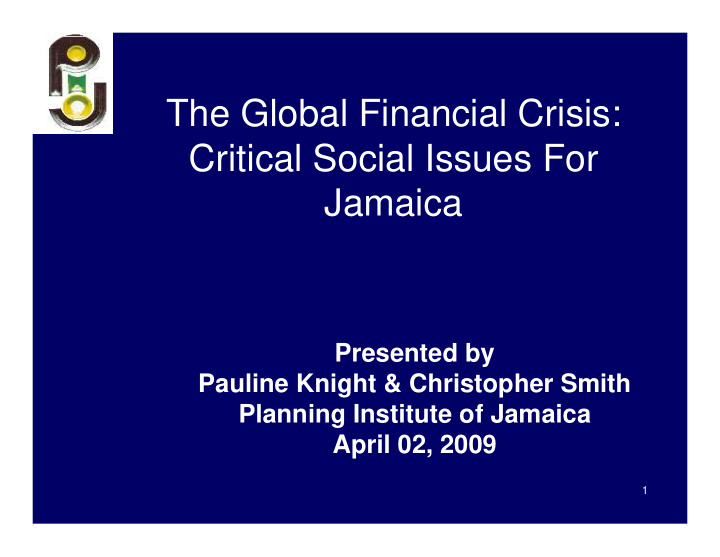



The Global Financial Crisis: Critical Social Issues For Jamaica Presented by Pauline Knight & Christopher Smith Planning Institute of Jamaica April 02, 2009 1
Outline of Presentation � Jamaica and its position in the global economy � Select macro economic and social indicators � Social Issues as a result of the global financial crisis � Jamaica’s response � Policy recommendations � Conclusion 2
Jamaica � Classified as a medium income country � GDP per capita estimated at US$ 5 075.6 in 2008 up from US$ 4 811.0 in 2007 � Population as at October 2008 was 2.69 million 3
Jamaica Cont’d � Jamaica is highly integrated in the global economy � This is evident in its high degree of openness – 99 and 98 per cent 2006 and 2007 respectively � Any major shift in the global economy will have an impact on Jamaica 4
Select Indicators 2500.0 2000.0 1500.0 US$M 1000.0 500.0 0.0 2003 2004 2005 2006 2007 2008 Years Bauxite Tourism Remittances 5
What is the Impact on Jamaica? � Depreciation of the Jamaican currency � Inflation � Contraction in industries (lay-offs, closures & salary cuts) � Contraction in GDP � Reduction in Government revenue – budgetary constraints � Reduction in remittances 6
Emerging Social Issues � Contraction in GDP � Smaller national ‘pie’ to share � Currency Depreciation/Inflation � Higher prices � Reduction in purchasing power for all HH � Increase in HH unable to meet basic needs i.e. more poverty 7
Emerging Social Issues • Contraction/Salary Cuts in Industries � Higher unemployment � Less income for affected HH � Increase in HH unable to meet basic needs i.e. more poverty � Communities in bauxite areas devastated 8
Emerging Social Issues Less health care Poorer Less HH Income Poorer School nutrition attendance Higher unemployment More Higher Children Crime At risk More More youth Female unemployment Unemployment Contraction In Industries 9
Emerging Social Issues � Reduced Revenue/Budgetary Constraints � Delay/cancellation of programmes/projects � Social well-being negatively affected � Decline in real wages in public sector � Less income for affected HH 10
Emerging Social Issues � Reduction in Remittances � Less income (cash/kind) for approx. 42% of HH � Reduction in HH expenditure on day-to- day needs (90% of remittances) � Increase in HH unable to meet basic needs i.e. more poverty 11
Summary of Social Effects � Reduction in purchasing power for all HH � Less income & day-to-day expenditure for some HH � Higher unemployment � Increase in poverty � Poorer nutrition � Poorer health � Higher crime � Lower school attendance � More youth and children at risk � More economic dependency for females � Less social/community well-being 12
Government’s Response � Government’s response is two-fold 1. Stimulus package 2. Social protection measures 13
Stimulus Package � 10% margin of preference to Jamaican owned companies in GOJ procurement policy. � 15% of procurement reserved for SMEs � J$650M allocated for on-lending to SMEs by financial institutions & Jamaica Business Development Centre 14
Stimulus Package Cont’d � Tax on dividends paid by non-listed companies abolished January 01, 2009 � Transfer tax reduced from 6.5% to 5% � Job placement services for laid off workers arranged with Heart Trust/NTA � NHT can make arrangements to either temporarily suspend mortgage payments, extend the loan period and reduce interest rates for persons suffering from loss of income 15
Stimulus Package Cont’d � Government will adjust regulation for classification of non-performing loans from 90 to 180 days. � US$300M loan from IDB to be accessed through the EXIM Bank � J$2.5 billion additional expenditure on local infrastructure (roads, drains, gullies etc) authorized 16
Ongoing Social Protection Initiatives � Increase (+40%) in beneficiaries of cash transfers i.e. PATH � Increase in the size of the PATH benefit � Nutrition programme in basic schools in one parish i.e. St. Mary (lack of funds prevented all island implementation) � Earmarked budgetary provisions for free lunches for PATH primary and secondary students � Waiver of fees for health care and tuition in secondary schools � Economic Empowerment Grants for PWD 17
Recommended Policies/Strategies for Positive Social Outcomes Household Income/Poverty � Reduce and contain inflation as its impact is most devastating on the poor and vulnerable � Encourage mortgage companies & other financial institutions to reduce financial burden on persons with loss of income e.g. suspend mortgages etc. � Stimulate growth in agriculture for local food production and also rural development � Raise income tax threshold 18
Recommended Policies/Strategies for Positive Social Outcomes Unemployment � Have pro-poor arrangements to encourage viable livelihoods e.g. MSE loan pool � Stimulate businesses through tax cuts etc. � Establish a registry of persons laid off to obtain household information and identify needs and appropriate provisions e.g. � Training & job placement services � Promote community based responses: o Communal enterprises (agri and non-agri) o System to promote volunteerism & engage volunteers 19
Recommended Policies/Strategies for Positive Social Outcomes Unemployment (cont’d) � Introduce unemployment insurance for the future as a partial alternative to redundancy payments and link to training for re-tooling Youth/Children/Women At Risk � Expand youth development programmes to absorb unattached youth and provide linkages to job market � Expand progs. like PATH & raise benefits 20
Recommended Policies/Strategies for Positive Social Outcomes Communities At Risk � Use geographic targetting tools (i.e. indicator mapping) to guide community interventions � Promote community based responses Health � Removal of User Fees esp for the poor 21
Recommended Policies/Strategies for Positive Social Outcomes Nutrition � Public education � School feeding esp. basic & primary schools Other � Special funding arrangements for temporary social assistance programmes for specific population groups e.g. a) Benefits for elderly, b) Economic Empowerment Grants for disabled 22
23 PRESENTATION END OF
Recommend
More recommend